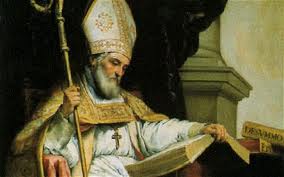
Summary: St Isidore, bishop and doctor of the Church. Born about 560 in Seville (Spain). He was proclaimed patron saint of the internet. Died there in 636.
Patrick Duffy tells his story.
St Isidore of Seville belonged to a strong religious family in 6th century Spain. His encyclopaedic knowledge, but not always original or accurate, led to his being proclaimed patron saint of the internet.
but not always original or accurate, led to his being proclaimed patron saint of the internet.
Two brothers bishops and a sister a distinguished abbess
Isidore’s family came from Cartagena in south eastern Spain, but he was probably born in Seville. His elder brother, Leander, became a great archbishop in Seville and is venerated as a saint as are another brother, Fulgentius, bishop of Ecija, and their sister, Florentina, a distinguished abbess.
Education
Leander oversaw Isidore’s education probably in a monastic school and he became the most learned person of his generation and a leading authority on a wide range of subjects through the Middle Ages.
Bishop of the Mozarabic liturgy
Isidore succeeded his brother Leander as bishop in 599. Recared, the Visigoth, had converted from Arianism to Catholicism and both he and Isidore made significant contributions to the culture of the new Catholic kingdom, especially in the composition of the distinctively Spanish, or what is now called Mozarabic liturgy.
Archbishop of Seville for thirty-six years , he laboured successfully to bring the Visigoths from Arianism to orthodox belief, who presided over several councils significant for Church life in Spain, and who codified the distinctive liturgy of the Spanish Church, which is preserved to this day. He is remembered for his prolific writings and as an influential educator, and highly regarded also for the pastoral care of his diocese. c/f The Australian Catholic lectionary.
His Etymologies
A compiler of popular knowledge rather than an original thinker, Isidore’s encyclopaedic work is called the Etymologies, or Origins, from the number of words whose meaning he explains. Its 20 volumes cover all human knowledge from grammar and mathematics to biology, geography, classical literature and theology. Acute critics point out that not all his explanations are correct. More critically approved today is his History of the Goths, Vandals and Suebi. Isidore also wrote a book of astronomy and natural history entitled De Rerum Natura. It is probably because of his encyclopaedic knowledge that he was chosen as the patron of the internet.
The Ideal Bishop
Isidore’s description of the ideal bishop is said to have inspired Pope John XXIII: “He who is set in authority for the education and instruction of the people for their good must be holy in all things and reprehensible in nothing….
Every bishop should be distinguished as much by his humility as by his authority… He is also to preserve that charity which exceeds all the other gifts and without which all virtue is nothing.” During his time he was dubbed the ‘Schoolmaster of the Middle ages.’
Death and Influence
Isidore died after a careful preparation in 636. It was only when his remains were removed to Leon on the route to Santiago de Compostela that his cult began to grow. In 1598 Pope Clement VIII (Ippolito Aldobrandini) canonised him. In 1722 Pope Innocent XIII (Michelangelo Conti) declared him a doctor of the Church.
He was named patron saint of the internet sometime in the mid-2000s.